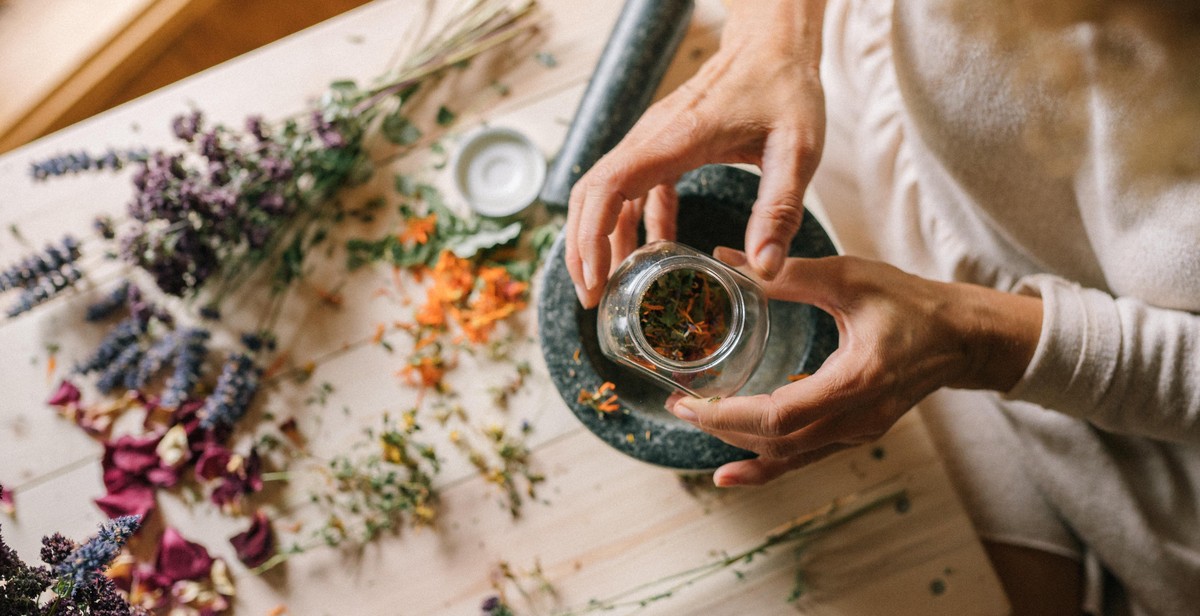Introduction
Herbs are a great way to add flavor to your meals and boost your overall health. However, buying fresh herbs can be expensive, and they don’t last very long. That’s where drying comes in. Drying herbs can help preserve their flavor and extend their shelf life. One way to dry herbs is by using a vertical herb drying rack. This DIY project is easy to make and can be done with just a few materials.
Why Use a Vertical Herb Drying Rack?
Using a vertical herb drying rack has many benefits. First, it’s space-saving. You can hang it on a wall or door, and it won’t take up any counter space. Second, it allows for better air circulation, which is crucial for drying herbs properly. Lastly, it’s a more eco-friendly option than using an electric dehydrator.
What You Will Need
Before you begin, you will need a few materials. These include:
- A wooden dowel
- Twine or string
- Screws and a drill
- Small hooks
- Scissors
- Herbs to dry
You can find these materials at your local hardware store or online.
How to Build a DIY Vertical Herb Drying Rack
Building a vertical herb drying rack is easy. Follow these steps:
- Cut the wooden dowel to your desired length using a saw or hand saw.
- Drill two holes on each end of the dowel, making sure they are evenly spaced.
- Cut six to eight pieces of twine or string, each about twice the length of the dowel.
- Tie one end of each piece of twine to a small hook.
- Thread the other end of each piece of twine through the holes in the dowel and tie a knot to secure it.
- Hang the hooks on a wall or door and space them evenly apart.
- Hang your herbs from the twine using clothespins or paperclips.
That’s it! Your DIY vertical herb drying rack is ready to use.

Why Build a DIY Vertical Herb Drying Rack?
Herbs are a staple in many kitchens. They add flavor, aroma, and color to dishes, making them more appetizing and enjoyable. However, fresh herbs have a limited shelf life, and if not used right away, they will wilt and spoil. Drying herbs is an excellent way to preserve their freshness and extend their usability. One of the best ways to dry herbs is by using a vertical herb drying rack.
Preserve the Freshness of Herbs
A DIY vertical herb drying rack is an efficient way to dry herbs without losing their flavor and aroma. Unlike other drying methods, a vertical drying rack allows air to circulate around the herbs, preventing mold and bacteria growth, and ensuring that the herbs dry evenly. This drying method also preserves the color and texture of the herbs, making them more appealing and attractive.
Save Money on Store-Bought Dried Herbs
Store-bought dried herbs can be expensive, and the quality may not always be up to par. Building a DIY vertical herb drying rack can save you money in the long run, as you can dry your own herbs and use them in your cooking. This way, you can ensure that the herbs are fresh, of high quality, and free from any additives or preservatives.
Customize Your Drying Rack
Building your own DIY vertical herb drying rack allows you to customize it to your specific needs and preferences. You can choose the size, shape, and materials that you want to use, depending on the space you have available and the herbs you want to dry. You can also add features such as hooks or clips to hang the herbs, making the drying process more efficient and organized.
Overall, building a DIY vertical herb drying rack is a practical and cost-effective way to preserve the freshness of your herbs and save money on store-bought dried herbs. It also allows you to customize your drying rack to suit your specific needs and preferences, making it a valuable addition to any kitchen.

Materials Needed
Wood and Hardware
- 2 – 1x4x8 pieces of pine or other wood of your choice
- 1 – 1x2x8 piece of pine or other wood of your choice
- 1 – 1x3x8 piece of pine or other wood of your choice
- 1 – 1/4 inch dowel rod, 36 inches long
- 1 – 1 1/4 inch pocket hole screws
- 1 – 2 inch wood screws
- Wood glue
- Sandpaper (80 and 120 grit)
Tools
- Power drill
- Drill bits (1/8 inch and 3/8 inch)
- 1 1/2 inch hole saw drill bit
- Pocket hole jig
- Clamps
- Square
- Tape measure
- Pencil
- Safety glasses
Optional
- Wood stain or paint
- Paintbrush or rag
Table of Cuts
| Wood | Cut | Quantity |
|---|---|---|
| 1×4 | Length | 6 – 36 inches |
| 1×2 | Length | 2 – 36 inches |
| 1×3 | Length | 2 – 36 inches |
| Dowel rod | Length | 1 – 36 inches |
With these materials and tools, you will be able to build a beautiful and functional vertical herb drying rack that will add a touch of rustic charm to your kitchen or garden. Make sure to follow the instructions carefully and take all necessary safety precautions. Happy building!
Step-by-Step Guide: How to Build a DIY Vertical Herb Drying Rack
If you’re looking for a way to preserve your herbs after harvesting, a DIY vertical herb drying rack is a great option. Here’s how to build one:
Step 1: Cut the Wooden Dowels
Start by cutting your wooden dowels to the desired length. You’ll need four pieces for each level of your drying rack. For a standard size rack, dowels that are 12 inches long work well.
Step 2: Drill Holes in the Pegboard
Next, drill holes in your pegboard where you want the wooden dowels to be attached. Make sure the holes are evenly spaced and the same size as the dowels.
Step 3: Attach the Wooden Dowels to the Pegboard
Insert the wooden dowels into the holes you drilled in the pegboard. Use wood glue to secure them in place. Let the glue dry completely before moving on to the next step.
Step 4: Add Hooks to the Pegboard
Attach hooks to the top of the pegboard. These will be used to hang the drying rack from a ceiling or wall. Make sure the hooks are securely in place and can support the weight of the rack and herbs.
Step 5: Hang the Drying Rack
Finally, hang your drying rack from the hooks you installed. Make sure it’s level and stable before adding your herbs. Hang your herbs from the wooden dowels using string or twine. Allow them to dry completely before storing or using.
| Materials Needed: | Tools Needed: |
|---|---|
| – Wooden dowels | – Drill |
| – Pegboard | – Saw |
| – Hooks | – Wood glue |
| – String or twine | – Measuring tape |
By following these simple steps, you can create a DIY vertical herb drying rack that will help preserve your herbs for months to come.

Tips for Using Your DIY Vertical Herb Drying Rack
Now that you have successfully built your own herb drying rack, it’s time to put it to use. Here are some tips to ensure that you get the best results:
Harvest Herbs at the Right Time
The ideal time to harvest herbs for drying is when they are at their peak flavor and fragrance. This is usually in the morning after the dew has dried but before the sun gets too hot. Avoid harvesting herbs that are wet or damp, as this can cause mold to develop during the drying process.
Clean Herbs Before Drying
Before placing your herbs on the drying rack, it’s important to remove any dirt, insects, or damaged leaves. Rinse your herbs gently under cool water and pat them dry with a paper towel or clean cloth. You can also use a salad spinner to remove excess moisture.
Space Herbs Evenly on the Rack
When placing your herbs on the drying rack, make sure to space them evenly to allow for proper air circulation. This will help prevent mold and ensure that all of your herbs dry evenly. Avoid overcrowding the rack, as this can also lead to mold and slow down the drying process.
Monitor Drying Progress
Check your herbs regularly to monitor their drying progress. Depending on the type of herb and the humidity in your area, it can take anywhere from a few days to a few weeks for your herbs to dry completely. When your herbs are dry, they should be crisp and crumble easily.
Store Dried Herbs Properly
Once your herbs are dry, store them in an airtight container in a cool, dark place. This will help preserve their flavor and fragrance. Avoid storing your herbs in direct sunlight or in a humid environment, as this can cause them to lose their potency or develop mold.
| Tip | Description |
|---|---|
| Harvest Herbs at the Right Time | Harvest herbs in the morning when they are at their peak flavor and fragrance. |
| Clean Herbs Before Drying | Remove any dirt, insects, or damaged leaves before placing herbs on the drying rack. |
| Space Herbs Evenly on the Rack | Space herbs evenly to allow for proper air circulation and prevent mold. |
| Monitor Drying Progress | Check herbs regularly and remove them from the rack when they are dry and crisp. |
| Store Dried Herbs Properly | Store dried herbs in an airtight container in a cool, dark place to preserve their flavor and fragrance. |
Conclusion
Building a DIY vertical herb drying rack is a fun and rewarding project that can help you preserve your herbs for future use. With some basic materials and tools, you can create a functional and stylish drying rack that will add a touch of charm to your kitchen or garden.
Tips for Success
- Choose a location for your drying rack that is dry and well-ventilated.
- Harvest your herbs when they are at their peak freshness and flavor.
- Avoid overcrowding your drying rack to ensure proper air circulation.
- Check your herbs regularly for signs of mold or mildew.
- Store your dried herbs in airtight containers in a cool, dry place.
Benefits of DIY Herb Drying Racks
There are many benefits to building your own herb drying rack, including:
- Cost savings compared to purchasing pre-made racks
- Customization options to fit your specific needs and style preferences
- Satisfaction of creating a functional and beautiful piece of home decor
- Ability to harvest and preserve your own herbs for cooking and medicinal purposes
Final Thoughts
Whether you are an experienced DIY enthusiast or a beginner looking for a fun and easy project, building a DIY vertical herb drying rack is a great way to add value to your home and garden. With a little creativity and some basic skills, you can create a functional and beautiful piece that will provide you with fresh herbs all year round.
